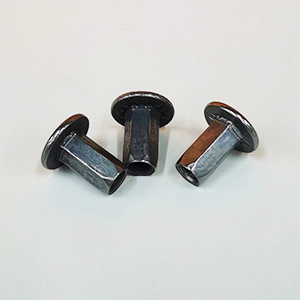1. Bolts|Nuts cannot be tightened
Reason: There is a gap between the workpieces or the polished part of the bolt is exposed to a large length on the surface of the workpiece, and the thickness of the washer is not enough;
Solution: Tighten after eliminating the gap between the workpiece, replace the bolts or thickened washers and tighten again;
2. There is a gap between the bolt head, nut and workpiece
Cause: Not tightened, the polished part of the bolt is long, and the center of the screw hole is not perpendicular to the surface of the workpiece, resulting in a single-sided gap;
Solution: Tighten, replace bolts or thicken washers, the workpiece is allowed to be filed flat or inclined washers are allowed, the hole diameter is enlarged, and the diameter of the bolt is increased (filing of the bolt head or nut is not allowed);
3. The bolt is broken or tripped
Cause: The tightening torque is too large, exceeding the allowable tightening torque, the bolts and nuts, and the threads are not aligned or the thread pitch does not meet the tightening requirements;
Solution: Replace the bolts, control the tightening torque, replace the bolts and nuts and retighten them;
4. The head of the countersunk head bolt protrudes out of the workpiece surface out of tolerance.
Cause: The depth of the socket is not enough, and the center line of the socket and the center line of the hole are not concentric;
Solution: Replace the drill bit, re-drill the hole to the qualified depth, increase the bolts, and re-drill the hole;
5. Bolts with 6-corner heads and rounded corners
Cause: The wrong wrench is selected or worn, the selected socket wrench is not placed in place, and the contact with the 6-angle head is small and causes sliding;
Solution: Replace the bolt, choose a suitable wrench, replace the bolt, and the socket wrench should be in place when tightening;
6. Unqualified constant force and moment
Causes: The tightening torque is too large or too small, the fixed force wrench is used incorrectly, and after the force is fixed, the cotter pin position is unqualified and the torque is changed;
Solution: Calculate the force according to the torque value given in the drawing, and use a calibrated wrench in accordance with relevant regulations. When determining the force, consider the position of the cotter pin or replace the washer;
7. Self-locking nut failure
Cause: The self-locking nut has been disassembled too many times or the locking part of the self-locking nut is defective;
Solution: Replace the nut;
8. Open pin activities
Cause: The diameter of the cotter pin selected is different from the hole diameter of the bolt cotter pin. When the cotter pin is installed, the round head is not tight, and it is not pressed tightly or buckled in the nut groove when bending;
Solution: Replace the cotter pin, retighten it, replace the cotter pin, and tighten the cotter pin correctly.

Related News
- Types of wire drawing rivets and anti-rust methods
- What are the functions of rivets?
- How to use blind rivets
- What is a rivet nut?
- Structure introduction and maintenance of rivet gun
- Application of Lantern Rivet Nut
- Classification and application of rivet standoffs
- The working principle and selection rules of riveting gun
- The use of rivet nuts
- Comparison of drawing rivet connection and traditional craftsmanship
- Introduction to the application and performance of wire drawing rivets
- How to prevent oxidation of rivets
- Characteristics of lantern rivets
- Precautions when using ring groove rivets
- Advantages and precautions of ring groove rivets
- What are the types of rivets?
- Several common riveting guns
- The purpose and working principle of blind rivet nuts
- Features of Seahorse Rivets
- Heat treatment of blind rivets



